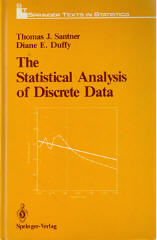
This is a graduate level introduction to the use of loglinear models to analyze discrete multivariate data and to the analysis of binary response data, including 2 X 2 tables, stratified 2 X 2 tables, and binary regression
The Statistical Analysis of Discrete Data provides an introduction to current statistical methods for analyzing discrete response data. The book can be used as a course text for graduate students and as a reference for researchers who analyze discrete data. The book's mathematical prerequisites are linear algebra and elementary advanced calculus. It assumes a basic statistics course which includes some decision theory, and knowledge of classical linear model theory for continuous response data. Problems are provided at the end of each chapter to give the reader an opportunity to apply the methods in the text, to explore extensions of the material covered, and to analyze data with discrete responses. In the text examples, and in the problems, we have sought to include interesting data sets from a wide variety of fields including political science, medicine, nuclear engineering, sociology, ecology, cancer research, library science, and biology.
Although there are several texts available on discrete data analysis, we felt there was a need for a book which incorporated some of the myriad recent research advances. Our motivation was to introduce the subject by emphasizing its ties to the well-known theories of linear models, experimental design, and regression diagnostics, as well as to describe alternative methodologies (Bayesian, smoothing, etc.); the latter are based on the premise that external information is available. These overriding goals, together with our own experiences and biases, have governed our choice of topics.
The text covers both single sample problems (Chapter 2) and problems with structured means which can be studied via loglinear and logistic models (Chapters 3 through 5). Classical maximum likelihood estimators, as well as estimators based on Bayesian, smoothing, shrinkage, and ridge approaches, are described for estimating parameters in structured and unstructured problems. Maximum likelihood estimation theory for loglinear models is developed via the notion of linear projection to highlight the similarities with maximum likelihood estimation for normal linear models. In addition to the standard testing and estimation formulations, problems of simultaneous interval estimation, multiple comparisons, and ranking and selection are considered with references to the appropriate literature. We describe and compare various small sample methods, especially for common confidence interval problems, as these are widely used in applications. Descriptions of recent research on graphical models for contingency tables, and diagnostic tools for loglinear models and logistic regression are included.
This book is not intended to cover every aspect of the statistical analysis of discrete data. Many important topics, such as measures of association, models for measuring change, the analysis of ordinal data, incomplete and missing data, and the analysis of panel and repeated measurement data are not included.
|
Thomas Santner is a Professor of Statistics at the Ohio State University. He is former Department Chair and former Director of the department's Statistical Consulting Service. Santner is also co-author, with Robert Bechhofer and Dave Goldsman, of ``Design and Analysis of Experiments for Statistical Selection, Screening, and Multiple Comparisons.'' He is a Fellow of the American Statistical Association and the Institute of Mathematical Statistics. Diane Duffy is Executive Director, Business Management at Telcordia Technologies, Inc. She is responsible for business processes in Applied Research related to commercial customers and contracts, intellectual property and pricing, and risk review and management. She also coordinates marketing for Applied Research, including Telcordia's ARgreenhouse web site (www.ARgreenhouse.com).
|
Dr. Diane Duffy Telcordia Technologies, Inc. 445 South Street MCC-1C311B Morristown, NJ 07960-6438 USA Email: diane@research.telcordia.com |
Professor Thomas Santner Department of Statistics Ohio State University 1958 Neil Avenue Columbus, OH 43210-1247 USA Email: tjs@stat.ohio-state.edu |
Springer-Verlag with home pages in Germany and the USA.